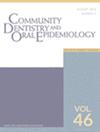Early Life Trajectories of Household Poverty and Area-Level Deprivation and Childhood Dental Caries: A Longitudinal Data Linkage Cohort Study
Abstract
Objective
This study aimed to explore the longitudinal impact of changes in household income poverty and area-based socioeconomic deprivation on dental caries prevalence in early childhood.
Methods
Data from the Growing Up in Scotland (GUS) longitudinal study (2005/6-2009/10) were linked to dental caries experience data at age 5 from Scotland's National Dental Inspection Programme. Latent Class Analysis identified trajectories of household poverty (income below 60% of the national median) and area-based deprivation across multiple time points between birth and age 5. Cumulative exposure scores were also calculated, and modified Poisson regression assessed associations between socioeconomic pathways and caries experience in 2893 children.
Results
Children living in persistent household poverty or in socioeconomically deprived areas had the highest caries experience risk compared to children never in poverty or deprivation. Elevated caries risk was also observed in children falling into poverty (aRR = 1.4; 95% CI = [1.1–1.8]) and escaping poverty (aRR = 1.6; 95% CI = [1.3–2.1]). Children moving into more deprived areas had higher caries risk (aRR = 1.6; 95% CI = [1.2–2.2]), while moving out of deprived areas did not increase risk (aRR = 1.1; 95% CI = [0.8–1.7]). Caries risk increased with years spent in household poverty and in deprived areas.
Conclusions
Unstable poverty and downward socioeconomic deprivation mobility were associated with greater caries risk in early childhood, underscoring the importance of considering the duration and persistence of socioeconomic disadvantage in relation to oral health outcomes and should inform early-years focused policies to address these. Longitudinal data linkage combining representative surveys and routine data is a powerful way to uncover these issues.


 求助内容:
求助内容: 应助结果提醒方式:
应助结果提醒方式:


